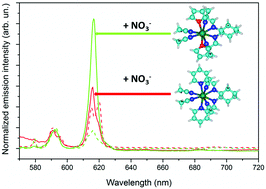Structural, optical and sensing properties of novel Eu(iii) complexes with furan- and pyridine-based ligands†
Abstract
A new family of imine and amine-based racemic ligands containing furan or pyridine as an aromatic donating ring [N,N′-bis(2-pyridylmethylidene)-1,2-(R,R + S,S)-cyclohexanediamine, L1; N,N′-bis(2-furanylmethylidene)-1,2-(R,R + S,S)-cyclohexanediamine, L2; N,N′-bis(2-pyridylmethyl)-1,2-(R,R + S,S)-cyclohexanediamine, L3; and N,N′-bis(2-furanylmethyl)-1,2-(R,R + S,S)-cyclohexanediamine, L4] and their trifluoromethanesulphonate (CF3SO3−, OTf−) and nitrate Eu(III) complexes is studied in acetonitrile (AN) solution. The stoichiometry and stabilities of the formed complexes are obtained by means of spectrophotometric titrations: when Eu(III) triflate is used as a starting salt, two mononuclear species (1 : 1 and 1 : 2) are detected, while only the 1 : 1 complex is observed when the nitrate salt is employed. The stability of these complexes, as well as the geometry of their Eu(III) environment, is significantly dependent on the nature of the ligand employed (imine or amine, furan or pyridine-based). DFT calculations show that all donor atoms are coordinated to the metal ion in the 1 : 1 EuL(L = L1–L4) species and suggest that the higher stability of the complexes with L1 and L2 with respect to L3 and L4 is mostly due to the higher degree of preorganization of the former species. The optical response of the imine-based L1 and L2 Eu complexes, produced by NO3− coordination, has been studied in order to assess their application as sensing devices. With both ligands, an increase of the emission intensity on the addition of the nitrate ion is observed. This is higher for the EuL2 complex and underlines the important role of the nature of the heteroaromatic ring. Finally, it is worth noting that an efficient energy transfer process from the ligand to the metal is present in the case of the 1 : 1 triflate Eu(III) complex with the ligand L1.


 Please wait while we load your content...
Please wait while we load your content...